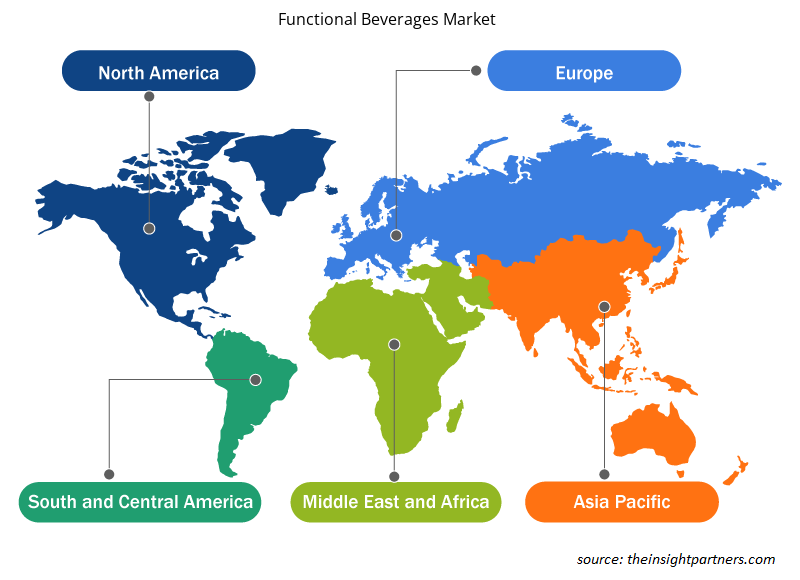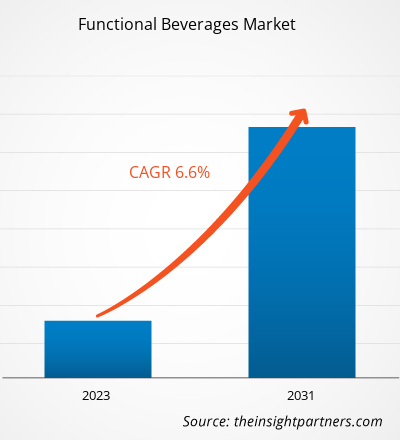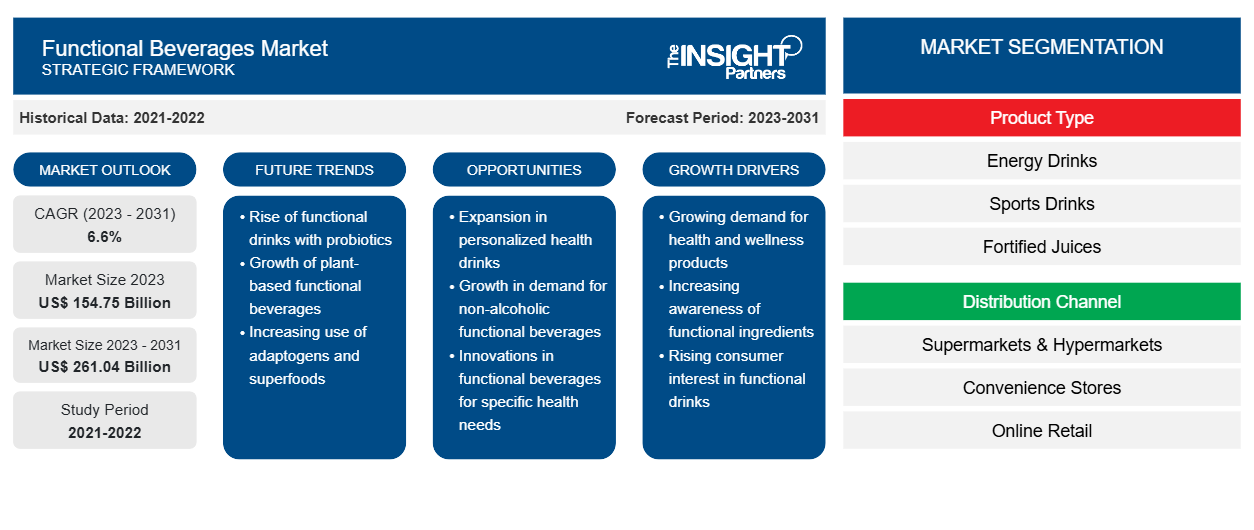Si prevede che la dimensione del mercato delle bevande funzionali raggiungerà i 261,04 miliardi di dollari entro il 2031, rispetto ai 154,75 miliardi di dollari del 2023. Si prevede che il mercato registrerà un CAGR del 6,6% nel periodo 2023-2031. È probabile che la crescente consapevolezza della salute rimanga una delle principali tendenze del mercato delle bevande funzionali.
Analisi del mercato delle bevande funzionali
L'analisi del mercato delle bevande funzionali ha rivelato un panorama fiorente e dinamico guidato dalle preferenze dei consumatori in evoluzione, dai progressi tecnologici e dalle tendenze di salute e benessere. La crescente consapevolezza della salute tra i consumatori ha fatto aumentare la domanda di bevande che offrono benefici funzionali oltre all'idratazione di base. Ciò include bevande arricchite con vitamine, minerali, antiossidanti, probiotici e altri ingredienti bioattivi per supportare obiettivi di salute specifici come aumento di energia, supporto immunitario, salute digestiva e riduzione dello stress. Le tendenze di mercato indicano uno spostamento verso prodotti clean-label con ingredienti naturali, lavorazione minima e trasparenza nelle pratiche di approvvigionamento e produzione.
Panoramica del mercato delle bevande funzionali
Il mercato delle bevande funzionali ha registrato una crescita significativa negli ultimi anni grazie alla crescente consapevolezza dei consumatori sui benefici per la salute associati a queste bevande. Oltre all'idratazione di base, le bevande funzionali offrono anche benefici per la salute aggiuntivi come energia migliorata, funzioni cognitive, immunità o gestione del peso. Queste bevande sono arricchite con vitamine, erbe, minerali o altri ingredienti per promuovere la salute e il benessere. Uno dei fattori chiave che guidano la crescita del mercato delle bevande funzionali è la crescente domanda di soluzioni per la salute comode e da asporto. Stili di vita frenetici e una crescente attenzione al benessere hanno portato i consumatori a cercare bevande che non solo abbiano un buon sapore, ma che forniscano anche benefici funzionali. Questa tendenza ha portato allo sviluppo di un'ampia gamma di bevande funzionali, tra cui bevande energetiche, bevande sportive, acque fortificate e tè e caffè pronti da bere.
Personalizza questo report in base alle tue esigenze
Riceverai la personalizzazione gratuita di qualsiasi report, comprese parti di questo report, o analisi a livello nazionale, pacchetto dati Excel, oltre a usufruire di grandi offerte e sconti per start-up e università
-
Scopri le principali tendenze di mercato in questo rapporto.Questo campione GRATUITO includerà analisi di dati che spaziano dalle tendenze di mercato alle stime e alle previsioni.
Driver e opportunità del mercato delle bevande funzionali
Aumentare la consapevolezza della salute
Il passaggio a stili di vita più sani ha spinto la domanda di bevande funzionali che offrano più della semplice idratazione. I consumatori sono sempre più alla ricerca di bevande che forniscano ulteriori benefici per la salute, come vitamine, minerali, antiossidanti, probiotici e altri ingredienti bioattivi. Queste bevande funzionali sono percepite come alternative più sane alle tradizionali bevande zuccherate, in linea con le scelte dei consumatori attenti alla salute che cercano di migliorare il loro benessere generale. Vitamine e minerali sono nutrienti essenziali che supportano varie funzioni corporee, mentre gli antiossidanti aiutano a combattere lo stress ossidativo e l'infiammazione nel corpo. D'altro canto, i probiotici promuovono la salute intestinale e la digestione introducendo batteri benefici nel sistema digerente.
Crescente interesse per il benessere e la cura di sé
La crescente attenzione al benessere e alla cura di sé ha influenzato significativamente le preferenze dei consumatori, portando a un'impennata della domanda di bevande funzionali su misura per supportare specifici obiettivi di salute. Che si tratti di aumentare i livelli di energia, rafforzare il sistema immunitario, promuovere la salute digestiva, gestire il peso o ridurre lo stress, i consumatori cercano bevande che offrano benefici funzionali mirati in linea con i loro obiettivi di benessere.
Analisi della segmentazione del rapporto di mercato sulle bevande funzionali
I segmenti chiave che hanno contribuito alla derivazione dell'analisi di mercato delle bevande funzionali sono il tipo di prodotto e il canale di distribuzione.
- In base al tipo di prodotto, il mercato delle bevande funzionali è segmentato in bevande energetiche, bevande sportive, succhi fortificati, acqua funzionale e altri. Il segmento delle bevande energetiche ha detenuto la quota di mercato maggiore nel 2023.
- In base al canale di distribuzione, il mercato delle bevande funzionali è segmentato in supermercati e ipermercati , minimarket, vendita al dettaglio online e altri. Il segmento supermercati e ipermercati ha detenuto la quota di mercato maggiore nel 2023.
Analisi della quota di mercato delle bevande funzionali per area geografica
L'ambito geografico del rapporto sul mercato delle bevande funzionali è suddiviso principalmente in cinque regioni: Nord America, Asia Pacifico, Europa, Medio Oriente e Africa e Sud America/Sud e Centro America.
Il mercato delle bevande funzionali del Nord America sta crescendo notevolmente a causa della popolazione in crescita e del boom dell'industria alimentare e delle bevande. Il crescente numero di individui attenti alla salute e al fitness nel Nord America ha aumentato la domanda di prodotti funzionali, con un impatto su tutti gli elementi del menu; la categoria delle bevande offre la più grande opportunità di innovazione del gusto. Inoltre, la popolarità delle bevande analcoliche e delle bevande vegetali a zero calorie, zero zuccheri e a basso contenuto di carboidrati sta crescendo in tutta la regione, guidando il mercato delle bevande funzionali. Inoltre, la crescente popolazione vegana e la crescente tendenza al veganismo stanno aumentando la domanda di bevande funzionali vegetali, come il latte vegetale.
Approfondimenti regionali sul mercato delle bevande funzionali
Le tendenze regionali e i fattori che influenzano il mercato delle bevande funzionali durante il periodo di previsione sono stati ampiamente spiegati dagli analisti di Insight Partners. Questa sezione discute anche i segmenti e la geografia del mercato delle bevande funzionali in Nord America, Europa, Asia Pacifico, Medio Oriente e Africa e America centrale e meridionale.

- Ottieni i dati specifici regionali per il mercato delle bevande funzionali
Ambito del rapporto di mercato sulle bevande funzionali
| Attributo del report | Dettagli |
|---|---|
| Dimensioni del mercato nel 2023 | 154,75 miliardi di dollari USA |
| Dimensioni del mercato entro il 2031 | 261,04 miliardi di dollari USA |
| CAGR globale (2023-2031) | 6,6% |
| Dati storici | 2021-2022 |
| Periodo di previsione | 2023-2031 |
| Segmenti coperti |
Per tipo di prodotto
|
| Regioni e Paesi coperti |
America del Nord
|
| Leader di mercato e profili aziendali chiave |
|
Densità degli attori del mercato delle bevande funzionali: comprendere il suo impatto sulle dinamiche aziendali
Il mercato delle bevande funzionali sta crescendo rapidamente, spinto dalla crescente domanda degli utenti finali dovuta a fattori quali l'evoluzione delle preferenze dei consumatori, i progressi tecnologici e una maggiore consapevolezza dei benefici del prodotto. Con l'aumento della domanda, le aziende stanno ampliando le loro offerte, innovando per soddisfare le esigenze dei consumatori e capitalizzando sulle tendenze emergenti, il che alimenta ulteriormente la crescita del mercato.
La densità degli operatori di mercato si riferisce alla distribuzione di aziende o società che operano in un particolare mercato o settore. Indica quanti concorrenti (operatori di mercato) sono presenti in un dato spazio di mercato in relazione alle sue dimensioni o al valore di mercato totale.
Le principali aziende che operano nel mercato delle bevande funzionali sono:
- PepsiCo
- La Coca-Cola Company
- Nestlé
- La società Kraft Heinz
- MULINI GENERALI, INC.
- Danone SA
Disclaimer : le aziende elencate sopra non sono classificate secondo un ordine particolare.

- Ottieni una panoramica dei principali attori del mercato delle bevande funzionali
Notizie e sviluppi recenti sul mercato delle bevande funzionali
Il mercato delle bevande funzionali viene valutato raccogliendo dati qualitativi e quantitativi post-ricerca primaria e secondaria, che includono importanti pubblicazioni aziendali, dati associativi e database. Di seguito è riportato un elenco degli sviluppi nel mercato delle bevande funzionali:
- Tropicana Products Inc. ha lanciato due nuovi gusti di frullati contenenti vitamina C. I Tropicana's Smoothie Pineapple & Mango e Strawberry & Banana saranno venduti al dettaglio in tutta l'India in tutti i canali di distribuzione operativi sul mercato. (Fonte: Tropicana, News, 2023)
- Dole Packaged Foods ha annunciato 11 nuovi lanci di prodotti. Si prevede che questa trasformazione sarà guidata da un nuovo team dirigenziale in Nord America composto da quattro donne, un mix di dirigenti assunti di recente e di ruolo con un solido background e competenza nelle aree di brand building e sviluppo di prodotti. (Fonte: Dole, sito web, 2023)
Copertura e risultati del rapporto sul mercato delle bevande funzionali
Il rapporto "Dimensioni e previsioni del mercato delle bevande funzionali (2021-2031)" fornisce un'analisi dettagliata del mercato che copre le seguenti aree:
- Dimensioni e previsioni del mercato a livello globale, regionale e nazionale per tutti i segmenti di mercato chiave coperti dall'ambito
- Dinamiche di mercato come fattori trainanti, vincoli e opportunità chiave
- Principali tendenze future
- Analisi dettagliata delle cinque forze PEST/Porter e SWOT
- Analisi di mercato globale e regionale che copre le principali tendenze di mercato, i principali attori, le normative e gli sviluppi recenti del mercato
- Analisi del panorama industriale e della concorrenza che copre la concentrazione del mercato, l'analisi della mappa di calore, i principali attori e gli sviluppi recenti
- Profili aziendali dettagliati
- Analisi storica (2 anni), anno base, previsione (7 anni) con CAGR
- Analisi PEST e SWOT
- Valore/volume delle dimensioni del mercato - Globale, Regionale, Nazionale
- Industria e panorama competitivo
- Set di dati Excel
Report recenti
Testimonianze
Motivo dell'acquisto
- Processo decisionale informato
- Comprensione delle dinamiche di mercato
- Analisi competitiva
- Analisi dei clienti
- Previsioni di mercato
- Mitigazione del rischio
- Pianificazione strategica
- Giustificazione degli investimenti
- Identificazione dei mercati emergenti
- Miglioramento delle strategie di marketing
- Aumento dell'efficienza operativa
- Allineamento alle tendenze normative























 Ottieni un campione gratuito per - Mercato delle bevande funzionali
Ottieni un campione gratuito per - Mercato delle bevande funzionali